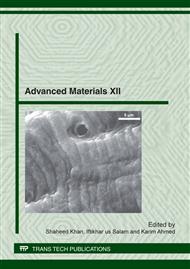[1]
W.F. Smith, Structure and properties of engineering alloys, McGraw-Hill Book company, New York, (1981).
Google Scholar
[2]
T.R. G. Kutty, K.N. Chandrasekharan, J.P. Panakkal, S.K. Ghosal, P.K. De, Use of ultrasonic velocity for nondestructive evaluation of ferrite content in duplex stainless steel, NDT International, 20(6) (2006) 359-361.
DOI: 10.1016/0308-9126(87)90294-x
Google Scholar
[3]
B. Kopec, V. Hanak, Ultrasonic attenuation in quenched railway wheels, NDT International, 22(1) (2006) 21-25.
DOI: 10.1016/0308-9126(89)91278-9
Google Scholar
[4]
M. Rosen, L. Ives, F. Biancaniello, R. Mehrabian, Correlation between ultrasonic and hardness measurements in aged aluminium alloy 2004, Mater. Sci Engg A 74 1985 1-10.
DOI: 10.1016/0025-5416(85)90104-1
Google Scholar
[5]
R. Parsad, S. Kumar, An investigation into the ultrasonic behavior of cast and heat-treated structure in steel NDT International 33(10) (2004) 506-508.
Google Scholar
[6]
VV. Murav'ev, Effect of heat treatment on the speed of ultrasound in aluminium alloys, Soviet J NDT 25(2) 1989 135-137.
Google Scholar
[7]
P. Palanichamy, A. Joseph, T. Jayakumar, B. Raj, Ultrasonic velocity measurements for estimation of grain size in austenitic stainless steel, NDT&E International, 28(3) 1995 179.
DOI: 10.1016/0963-8695(95)00011-l
Google Scholar
[8]
ER. Generazio. Ultrasonic determination of recrystallization, In: Thompson DO, Chimenti DE, editors, Review of progress in quantitative nondestructive evaluation, 6B, Newyork, Plenum press, 1463-1473, (1987).
DOI: 10.1007/978-1-4613-1893-4_165
Google Scholar
[9]
RC. Stiffler, M. Daly, RC. Wojnar, Measurement of degree of recrystallization in aluminium sheet using horizontally polarized sheer waves, In: PK. Liaw, O. Buck, RJ. Arsenault, RE. Green, editors, Non-destructive evaluation and material properties II, London, The Minerals, Metals& Materials Society, 1994 161-170.
Google Scholar
[10]
M. Vasudevan, P. Palanichamy, S. Venkadesan, Novel Technique for characterizing the annealing behavior. Scripta Metal et Mater. 30(11) 1994; 1479-83.
DOI: 10.1016/0956-716x(94)90249-6
Google Scholar
[11]
T. Lukomski, T. Stepinski, Steel Hardness Evaluation based on Ultrasound Velocity Measurements. The Journal British Institute of NDT, 23(11) 2010; 592-596.
Google Scholar
[12]
P. Mullner, C. Solenthaler, On the effect of deformation twining on defect densities, Matterial Sci Engg. ( 1997) 107-15.
Google Scholar
[13]
P. Mullner,. Disclination models for deformation twining, Solid State Phenom, 87 (2002) 227-38.
Google Scholar
[14]
N. Paulus, PJ. Uggowitzer, P. Mullner, MO. Speidel, Cold and warm work of austenite nitrogen steels, La metallurgia Italiana, 86(12) 1994, 603-8.
Google Scholar
[15]
B.D. Cullity; Elements of X-ray diffraction, third edition; USA, (1967).
Google Scholar


